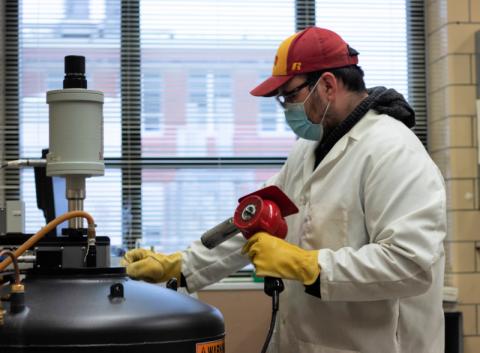
In the world of scientific journals, the order in which authors of a research paper are listed holds meaning, and first author especially so— it’s the person who drafted the manuscript and carried the heaviest load in the experimental work.
For graduate student Tyler Del Rose, it is a first first— with the research he began during his participation in the Science Undergraduate Laboratory Internships (SULI) program at the U.S. Department of Energy’s Ames Laboratory leading to his first first-authorship on a published scientific paper.
In 2018 and 2019, Del Rose participated in the U.S. Department of Energy’s SULI program at Ames Laboratory while an undergraduate student at the University of Michigan. He worked in a research group led by Vitalij Pecharsky, Ames Lab scientist and Iowa State University Anson Marston Distinguished Professor of Materials Science and Engineering, investigating the unique magnetic properties and structure-property relationships of rare-earth compounds. Some of these compounds are so new, scientists are still trying to understand their properties, how they work, and if they can be applied in new technologies or make existing ones more energy efficient.
In this case, Del Rose experimented with a newly discovered compound made of praseodymium, gadolinium, scandium, and germanium. To everyone’s surprise, it had nearly no detectable magnetization, not something you would expect from a compound that included gadolinium, the element that has the strongest localized, spin-only magnetic moment known in nature. The material also displayed very strong exchange bias, a magnetic phenomenon that is usually only found in artificial multilayered materials. It’s a property that is utilized in magnetic recording and appears to be intrinsic to this bulk material. Additionally, the material had unusual magnetic memory, in which the compound “remembers” the direction of a weak magnetic field it was initially exposed to but is not erased by much stronger opposing fields.
For Del Rose, the opportunity to study such an exotic and unique material was hard to resist.
“Being at a National Laboratory seems like the natural place to get your hands on the good stuff-- access to the kinds of equipment and materials that support research and discovery that is meaningful and exciting,” said Del Rose. He credits the guidance of his SULI mentor, Arjun Pathak (then a scientist in the same group at Ames Laboratory, now an assistant professor at Buffalo State University) with providing a learning environment in the midst of a professional lab setting.
“Being surrounded by researchers who are five, ten, or 20 years into their careers offers so many different perspectives and opportunities to gain knowledge. People here are very generous about sharing their time and expertise,” said Del Rose.
Now, Del Rose is a graduate student at Iowa State University and works in the same project under Pecharsky’s leadership, following up on the science that he explored as an intern— he’s working with the other scientists on the team to understand and explain the mechanisms of a plethora of unusual features discovered in this material. “Tyler is one of the best students I had the privilege to mentor,” said Pecharsky. “He is methodical and inquisitive, always willing to go the extra mile and genuinely optimistic. Witnessing the beginning of a great career in science is the best reward any mentor can hope for.”
The research is further discussed in the paper “Distinctive exchange bias and unusual memory effects in magnetically compensated Pr0.75Gd0.25ScGe,” authored by Tyler Del Rose, Arjun K. Pathak, Yaroslav Mudryk and Vitalij K. Pecharsky; and published in the Journal of Materials Chemistry C.
The SULI program is sponsored and managed by the DOE Office of Science’s, Office of Workforce Development for Teachers and Scientists (WDTS) in collaboration with DOE laboratories and facilities.
Ames Laboratory is a U.S. Department of Energy Office of Science National Laboratory operated by Iowa State University. Ames Laboratory creates innovative materials, technologies and energy solutions. We use our expertise, unique capabilities and interdisciplinary collaborations to solve global problems.
Ames Laboratory is supported by the Office of Science of the U.S. Department of Energy. The Office of Science is the single largest supporter of basic research in the physical sciences in the United States, and is working to address some of the most pressing challenges of our time. For more information, please visit https://energy.gov/science.
